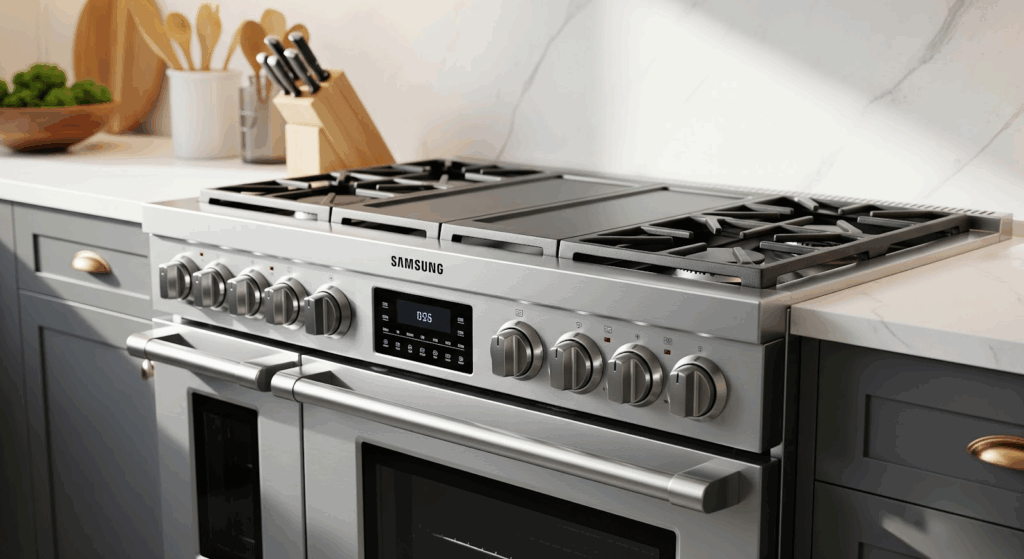
The relay control board in your Samsung electric range controls the power sent to the heating elements, which allows the oven to heat properly. Over time, regular use can cause this part to wear out or stop working. Fortunately, with a few basic tools and some patience, you can replace it yourself. Here’s how to do it.
Common Signs of a Faulty Relay Control Board
Knowing the symptoms can help you confirm the issue before starting the repair:
- Oven does not heat up at all
- Heating elements turn off unexpectedly during cooking
- The range display is on, but there is no heat in the oven or burners
- Error codes related to heating issues appear on the display
- Burners or oven elements remain stuck on and cannot be turned off
- Burned or melted areas on the board itself (visible after opening the panel)
Why the Relay Control Board Fails
Understanding the causes behind the failure can help you avoid future problems:
- Prolonged high-temperature exposure during extended cooking
- Power surges or electrical spikes
- Moisture or spills entering internal components
- Worn-out relays from frequent use
- Faulty wiring or loose connections
- Overloading circuits by using high-powered features simultaneously
- Poor ventilation around the appliance
Tools You Will Need
- Phillips head screwdriver
- Multimeter
- Wire stripper
- Adjustable wrench
- Flashlight
Safety First
Before you begin any work on your appliance, take the necessary precautions to stay safe and avoid damaging the unit:
- Always disconnect the range from power by unplugging it or turning off the circuit breaker.
- If the appliance has been used recently, allow it to cool down completely before beginning any work.
- Work at a steady pace to reduce the risk of injury or errors.
- Make sure your workspace is clean and well lit. Keep pets and children out of the area.
- Do not work with wet hands or in a damp environment.
- Refer to the user manual for any specific safety or installation instructions for your model.
- Handle all parts carefully to avoid damaging the appliance or injuring yourself.
- Wear insulated gloves to protect your hands from sharp edges or debris.
- Avoid direct contact with exposed wires or terminals. Use insulated tools or gloves when needed.
- Take photos or make notes of wire connections before disconnecting anything. This will help you reconnect everything correctly later.
How to Replace the Relay Control Board in a Samsung Range
Below are the steps to remove a faulty relay control board and install a new one in your Samsung range.
Power and Access
- Unplug the range from the power source.
- Pull the range away from the wall to access the rear panel.
- Use a Phillips head screwdriver to remove the screws securing the rear panel.
- Remove the rear panel and set it aside.
Remove the Faulty Relay Control Board
- Locate the relay control board near the bottom of the range above the terminal block.
- Disconnect all wiring from the old relay control board. Take a photo or note the wire configuration for reference.
- Remove the screws that hold the relay control board to the mounting bracket.
- Carefully remove the old relay control board.
Install the New Relay Control Board
- Align the new relay control board with the mounting bracket.
- Secure it using the screws removed earlier.
- Reconnect the wiring to the new board, matching the original configuration.
Reassembly and Testing
- Reattach the rear panel.
- Reinstall the Phillips head screws.
- Plug the range back into the power source.
- Push the range back into place.
- Test the range to confirm the new relay control board works properly.
Also Read: Pro tips for replacing the main control board in a Samsung range
Final Thoughts
Swapping out a faulty relay control board in your Samsung range isn’t something that needs a service call every time. With the right tools, a clear workspace, and a little focus, it’s totally doable on your own. Watching for the warning signs early and understanding what causes the issue can save you time and frustration down the line. It’s a smart way to keep your kitchen running without waiting around for a technician. If you’re up for the task, this fix might be easier than you expected—and a good way to get more confident with simple appliance repairs.
